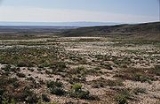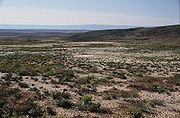
Knersvlakte
Encyclopedia
The Knersvlakte is a region of a hilly terrain covered with quartz gravel in Namaqualand
in the north-west corner of the Western Cape
Province of South Africa
. The name is thought to be derived from the gnashing of teeth caused by the hard quartz stones as they are traveled over in wagon. The Knersvlakte is succulent karoo
and dominated by leaf succulents belonging to the Mesembryanthemaceae and Crassulaceae
, with a variety of shrubs spread amongst them. The climate of the region is semi-arid with long dry summers, and rainfall occurring in the winter months.
 The white quartz gravel reflects the sunlight, and is not as hot as the darker rocks and soil found in adjacent areas. Because the area is isolated from other areas with abundant quartz stones, there is a high level of endemism in the plants that occur in the Knersvlakte. Many of these plants are small and compact, which is presumably an adaptation to absorb heat as rain occurs in a short and cool winter period.
The white quartz gravel reflects the sunlight, and is not as hot as the darker rocks and soil found in adjacent areas. Because the area is isolated from other areas with abundant quartz stones, there is a high level of endemism in the plants that occur in the Knersvlakte. Many of these plants are small and compact, which is presumably an adaptation to absorb heat as rain occurs in a short and cool winter period.
Namaqualand
Namaqualand is an arid region of Namibia and South Africa, extending along the west coast over and covering a total area of 170,000 square miles/440,000 km². It is divided by the lower course of the Orange River into two portions - Little Namaqualand to the south and Great Namaqualand to the...
in the north-west corner of the Western Cape
Western Cape
The Western Cape is a province in the south west of South Africa. The capital is Cape Town. Prior to 1994, the region that now forms the Western Cape was part of the much larger Cape Province...
Province of South Africa
South Africa
The Republic of South Africa is a country in southern Africa. Located at the southern tip of Africa, it is divided into nine provinces, with of coastline on the Atlantic and Indian oceans...
. The name is thought to be derived from the gnashing of teeth caused by the hard quartz stones as they are traveled over in wagon. The Knersvlakte is succulent karoo
Succulent Karoo
The Succulent Karoo is a desert ecoregion of South Africa and Namibia.-Setting:The Succulent Karoo stretches along the coastal strip of southwestern Namibia and South Africa's Northern Cape Province, where the cold Benguela Current offshore creates frequent fogs. The ecoregion extends inland into...
and dominated by leaf succulents belonging to the Mesembryanthemaceae and Crassulaceae
Crassulaceae
Crassulaceae, or the orpine family, are a family of dicotyledons. They store water in their succulent leaves. They are found worldwide, but mostly occur in the Northern Hemisphere and southern Africa, typically in dry and/or cold areas where water may be scarce...
, with a variety of shrubs spread amongst them. The climate of the region is semi-arid with long dry summers, and rainfall occurring in the winter months.


